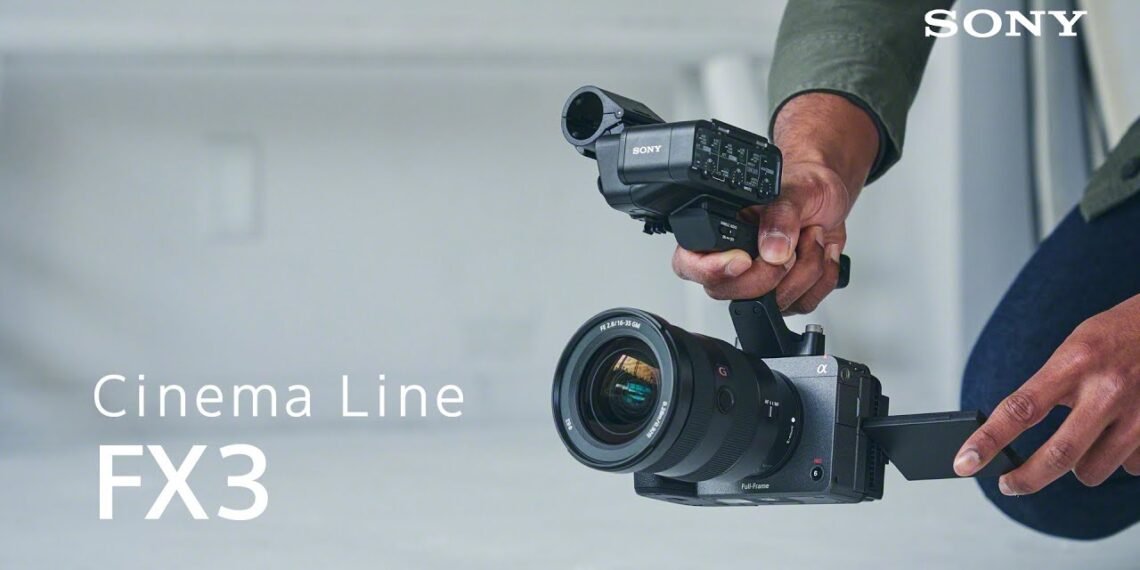Sony’s FX2 represents a notable shift in the company’s cinema camera lineup, stepping beyond its predecessor, the FX3. This new model integrates high-resolution imaging with enhanced photographic features, aiming to bridge the gap between professional video production and still photography. Its advanced design signals a fresh approach for the FX series.

By combining robust video capabilities with added photographic functionality, the FX2 offers flexibility for diverse creative needs. Packed with a new design and improvements that cater to filmmakers and hybrid shooters, it positions itself as a versatile option in Sony’s growing cinema camera portfolio.
Key Takeaways
- The Sony FX2 offers advanced video and photo capabilities.
- It introduces a fresh design in the FX camera lineup.
- This model targets hybrid creators with diverse needs.
Sony FX2 Review: A Look at Its Features
The Sony FX2 stands out in the cinema line due to its versatile 33-megapixel full-frame BSI sensor, which provides sharp oversampled 4K video at up to 30 frames per second. This sensor supports dual gain ISO settings, offering excellent dynamic range at ISO 800 with S-Log3 and maintaining low noise at the higher gain of ISO 4000. However, its processing speed falls short, leading to visible rolling shutter effects during oversampled 4K recordings and restricting full-width 4K at 60p to an APS-C crop format.
Video and Photo Features

A mechanical shutter adds flexibility for photographers who work on film sets. With an electronic first curtain shutter design, this mechanism helps minimize rolling shutter issues in photos—a functionality adapted from Sony’s a7C II camera. Flash sync for stills reaches speeds of up to 1/160 seconds. Notably, users can shoot JPEGs using S-Log3, enabling uniform grading across both photos and video footage for consistent aesthetics.
Recording is stored on memory cards, including CFexpress Type A (in a single slot that supports SD cards as well) and UHS-II SD cards. For typical video modes, an SD card suffices, while demanding All-I recording modes require the pricier CFexpress Type A cards.



The FX2 incorporates AI-powered autofocus, which excels in tracking moving subjects and enhancing dynamic framing. This makes it particularly useful for cinematic productions where precise subject focus is required. Paired with the BIONZ XR image processor, the camera ensures faster and more efficient data handling, boosting performance for both creative and professional use.
Limitations for RAW Video
While the camera does allow RAW video recording, it is limited to external capture at a resolution of 4.7K from the APS-C area of the sensor. For enthusiasts prioritizing RAW video, the FX2 might not meet high expectations, as internal RAW recording is absent.
Powering the Camera


The Sony FZ-100 battery, a widely-used option across Sony cameras, powers the FX2. On average, a single charge provides just over an hour of recording, balancing its compact design with functional usability for short shoots or bursts of production needs.

The FX2 brings together key features for hybrid cinema-photography workflows, while maintaining affordability relative to other models within the cinema line. The combination of AI-powered technology and practical design appeals to professionals who value adaptability in dynamic shooting environments.
Sony FX2 Review: Exploring the Exterior

The design of the Sony FX2 stands out primarily due to its bold electronic viewfinder (EVF), a first for the FX series. This feature is complemented by a large, comfortable eyecup and spaced far enough from the camera body to reduce accidental touches on the touch screen. An added advantage is the tilting capability of the EVF, making it easier to use when capturing shots from low angles. Its resolution of 3.69 million dots may not be groundbreaking, but it enhances visibility in bright conditions and aids in achieving precise focus. However, users might find that mounting a microphone receiver or external monitor can obstruct the EVF’s range of motion.
In contrast, the LCD screen feels less impressive. Though it offers full articulation and decent brightness, its 1.03-million-dot resolution doesn’t provide the clarity needed for detailed focus adjustment unless the user zooms in the display image. Because of this, many photographers might prefer relying on the EVF for better accuracy when framing or focusing.

The camera’s grip has been ergonomically improved, catering to users with larger hands. Its deeper design is comfortable while remaining slim enough to prevent interference from bulkier lenses often used in video work. Unfortunately, some of its external features, such as the flap covers for ports, aren’t as reliable. The HDMI and USB port covers, for instance, can be accidentally opened, exposing internal components to potential damage from dust or moisture.
Durability concerns aside, the FX2 shares many of its stylistic elements with earlier models like the FX3 and FX30. It features multiple 1/4-inch mounting points, a compact build, and weighs just 24 ounces (679 grams), making it suitable for handheld shooting or use with a gimbal. The addition of a top-mounted autofocus joystick provides easy access for some users, but it can be challenging to operate consistently when using the camera’s EVF.
This compact body design, combined with utility-focused elements like mounting options and its lightweight construction, reinforces the FX2’s purpose as a portable yet capable tool for creators. However, certain design aspects may leave users wishing for better refinement in handling and usability.
Sony FX2 Review: A Step Above the a7 IV
The Sony FX2 distinguishes itself among Sony mirrorless cameras by blending the compact features of Alpha bodies with the professional enhancements typical of the FX series. For those deciding between the FX2 and the smaller, less expensive a7 IV, several upgrades justify the move to this cinema-focused model.
Built-In Cooling System
One standout feature is the built-in cooling fan, designed for extended video recording sessions. Tests at room temperature showed consistent performance without overheating, even when using oversampled 4K modes. This makes the FX2 a practical choice for video creators who need dependable results during long takes.
Advanced Stabilization Options
While the a7 IV offers effective in-body image stabilization (IBIS), the FX2 introduces more advanced stabilization tools for smoother footage. The Dynamic Active Steadyshot provides highly stable video when shooting while in motion, such as walking. However, this mode applies a noticeable crop to the image, so users will need to weigh stabilization benefits against framing preferences.

Enhanced Video-Shooting Interface
The FX2 improves usability for video-intensive workflows by including thoughtful features like the Big 6 menu, which consolidates commonly used settings in a single view. This echoes the functionality seen in professional gear from brands such as Arri and Blackmagic, catering directly to serious video creators. Another helpful update is the ability to adjust the shutter by angle rather than speed, simplifying setups across varying frame rates. For anamorphic lens users, the camera provides a de-squeeze display for precise framing, although it supports only 1.33x and 2x squeeze ratios.
Autofocus Performance

The FX2 excels in autofocus capabilities thanks to its dedicated AI processor. This enhancement leads to accurate focus for both video and photography, ideal for capturing dynamic subjects such as skiers, animals, or children. The autofocus system delivers consistently sharp results, offering a significant edge over the a7 IV.
Sensor and Versatility
Equipped with a 33-megapixel sensor, the FX2 balances resolution and performance effectively. Designed for creators who want excellent autofocus, robust stabilization, and video-centric features, it serves as a strong alternative for those who find the compact a7C II too small or require more advanced capabilities than the a7 IV provides.
The Sony FX2 Excels in Many Areas

What Other Options Exist?
For those comparing the FX2 to other models in Sony’s lineup, it stands out for its balanced features in both photography and videography. The FX2, with its advanced autofocus, tilting electronic viewfinder, and improved stabilization, is an excellent choice over the a7 IV for video-focused users. These upgrades justify its higher cost for individuals like content creators who prioritize smooth workflows.
However, the FX3 remains a close competitor within Sony’s range. It offers faster sensor readout speeds, allowing full-width 4K at 60 fps and cropped 4K at 120 fps. While the FX3 leans more toward video performance, the FX2 provides sharper still images thanks to its 33MP sensor versus the FX3’s 12MP, along with enhanced autofocus features. Photographers or hybrid shooters may prefer the FX2, while those needing high-speed video might find the FX3 a better fit.
Outside of Sony, options from other manufacturers are worth exploring. Nikon’s Z6 IIIdelivers solid competition with its uncropped 4K at 60 fps, stacked sensor capabilities, and internal RAW video. However, the FX2 compensates with features like a built-in fan to manage overheating during longer shoots and superior autofocus reliability, which is appreciated by videographers handling dynamic scenes.
Similarly, Panasonic’s S1 II is a strong contender, boasting extensive recording options, such as open gate modes and comprehensive anamorphic support. It even supports internal RAW recording, which can appeal to high-end creators. Still, Sony leads in autofocus consistency, giving the FX2 an edge for scenarios where precision tracking matters most.
Is It the Camera for You?
The FX2 stands out as a reliable tool for those already invested in Sony equipment or ecosystems. Creators who need both strong video capabilities and high-quality still images will benefit from its hybrid design. The lack of severe limitations on its photographic performance makes it an attractive option for professionals who often switch between video and photo work.

On the other hand, potential buyers should carefully consider how the camera’s slower sensor might impact their projects. Rolling shutter artifacts and its cropped 4K output at higher frame rates can limit the FX2’s performance for certain fast-paced video work. For users who require uncompromised speed or who shoot extensively in 4K at high frame rates, exploring alternatives like the FX3 or other brands’ offerings could be a more suitable choice.
Ultimately, the FX2 appeals to a wide range of users—including photographers, videographers, and content creators—especially those valuing ease of use, dependable autofocus, and hybrid functionality in a single body.
Frequently Asked Questions
Does the Sony FX2 capture video in full-frame format?
Yes, the Sony FX2 is capable of recording in full-frame format, making it a suitable choice for creators seeking cinematic visuals and enhanced depth of field.
Is the Sony FX3 approved under Netflix’s camera guidelines?
High Image Quality:

The FX3 offers a 4K full-frame sensor with 15 stops of dynamic range, ensuring excellent image quality.
- Compact and Lightweight:
Its compact design makes it a popular choice for solo shooters and can also be used as a B-cam.
- Versatile:
The FX3 offers various shooting modes and features, including S-Gamut3Cine / S-Log3, making it suitable for different filming styles.
- Software Updates:
The FX3 has received firmware updates that enhance its capabilities, such as new log shooting modes and user LUT importing.
To use the FX3 for Netflix productions, follow these settings:
- Set the camera to UHD 3840 x 2160.
- Use the internal recording codec XAVC S-I 4K (ALL-I) 10-bit 4:2:2.
- Shoot in S-Gamut3Cine / S-Log3 or S-Gamut3 / S-Log3.
- Utilize the Sony TC Adaptor Cable for timecode sync.
What are the key features of the Sony FX3?
The Sony FX3 stands out with its compact design, active cooling for extended shooting sessions, dual memory card slots, and built-in cinematic color profiles. It also offers exceptional autofocus and advanced stabilization.
What is the highest frame rate supported by the Sony FX30?
The Sony FX30 can record at a maximum frame rate of 120 frames per second (fps) in 4K resolution, allowing for smooth slow-motion video captures.

How does the Sony FX2’s image quality compare with competitors?
The Sony FX2 provides excellent image quality for its price range, with accurate color reproduction and minimal rolling shutter effects. While its competitors might offer alternative strengths, the FX2 maintains solid performance for a cinema-focused camera.
Are there any limitations to the Sony FX2’s video recording capabilities?
The Sony FX2 has a few recording limitations, such as a lack of raw internal recording and restrictions on extended 4K slow-motion recording at high bit rates. These factors may impact users with specific production demands.
The Review
Sony FX2
Sony FX2 review: 33MP sensor & tilting EVF excel for photos/docs, but 4K60p requires S35 crop & rolling shutter persists. A cine-hybrid bargain at $2,699?





































